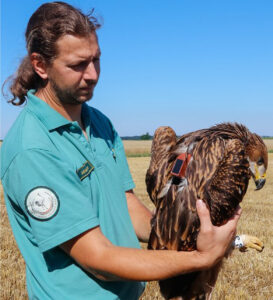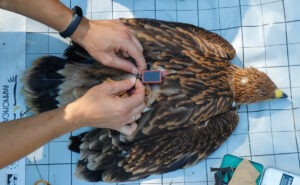Third International Scientific and Practical Conference “Eagles of the Palearctic: Study and Conservation”
Raptors Conservation. Suppl. 2. Proceedings of Conferences
Natal Dispersal of Eastern Imperial Eagles: Preliminary Results For the Central European Population
Schmidt M. (BirdLife Austria, Wien, Austria)
Árvay M. (MME / BirdLife Hungary, Budapest, Hungary)
Chavko J., Veselovsky T. (Raptor Protection Slovakia, Bratislava, Slovakia)
Horal D. (Czech Society for Ornithology, Brno, Czech Republic)
Raab R. (Technisches Büro für Biologie Rainer Raab, Deutsch-Wagram, Austria)
Ružić M. (Bird Protection and Study Society of Serbia, BirdLife in Serbia, Novi Sad, Serbia)
Wendelin B. (BirdLife Austria, Vienna, Austria)
Horváth M. (MME / BirdLife Hungary, Budapest, Hungary)
Contact:
Matthias Schmidt matthias.schmidt@birdlife.at
Arvay Marton arvay.marton@mme.hu
Jozef Chavko chavko@dravce.sk
Tomáš Veselovský veselovsky@dravce.sk
David Horal david.horal@seznam.cz
Rainer Raab rainer.raab@tbraab.at
Milan Ruzic milan.ruzic@pticesrbije.rs
Beate Wendelin beate.wendelin@aon.at
Márton Horváth horvath.marton@mme.hu
Recommended citation: Schmidt M., Árvay M., Chavko J., Veselovsky T., Horal D., Raab R., Ružić M., Wendelin B., Horváth M. Natal Dispersal of Eastern Imperial Eagles: Preliminary Results For the Central European Population. – Raptors Conservation. 2023. S2: 284–286. DOI: 10.19074/1814-8654-2023-2-284-286 URL: http://rrrcn.ru/en/archives/35086
The Central European Population of the Eastern Imperial Eagle (Aquila heliaca) is located on its most western global distribution edge. After a strong decline in the last two centuries the population recovered in the past decades not least due to extensive protection measurements. Conservation and scientific programs on international and national level were implemented in several countries especially in Hungary, Slovakia, Austria, Czech Republic and Serbia. In frame of these activities imperial eagle were tagged by satellite transmitter since 2003 in several projects by different organisations of the region.
In the current presentation we show preliminary results of an analysis of the natal dispersal movements of the immature birds of this residential population of Eastern Imperial Eagles. Therefore, more than 14 million data points of more than 130 individuals were available and analysed. We defined start of natal dispersal as the point when the young birds left their natal territory (5 km from natal nest) for at least 10 consecutive days. Because of high individual variability, we decided to classify the end of dispersal manually as the time the bird became territorial for the first time. We analysed movement pattern for the whole period of natal dispersal as well as for different life stages/ age classes. Therefor we distinguished between breeding (1.2–30.9) and non-breeding season (1.10–30.2) for each year of life of the birds. It turns out that daily travel ranges are higher during the breeding season than outside the breeding season and that activity decreases over the years until the birds start establishing a territory.
Furthermore, we estimate utilization distribution (UD) by calculating a dynamic Brownian Bridge Movement Model (dBBMM). Therefor in a first step, a dBBMM was calculated for each single individual. Those individual UDs were summarised up by using days of tracking as weight. The resulting UD gives an overview of distribution and space use of immature Eastern Imperial Eagles. It shows that while wide explorative flights of single birds occur, the majority of the birds stays mainly in Central Europe within the range of the breeding distribution of the population. Additional, there is a connection to the western parts of Greece and the island of Crete. The results help to enhance knowledge about habitat use and identify hotspots for further conservation efforts.

Tibor Juhász with the juvenile Imperial Eagle (Aquila heliaca), tagged with Ornitela transmitter. Photo by M. Horvath.

